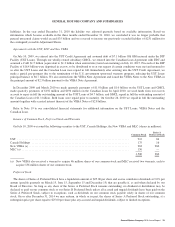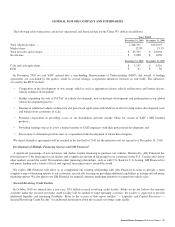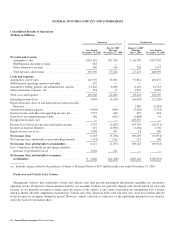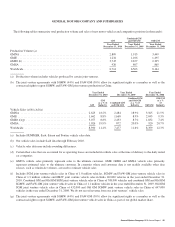General Motors 2010 Annual Report Download - page 44
Download and view the complete annual report
Please find page 44 of the 2010 General Motors annual report below. You can navigate through the pages in the report by either clicking on the pages listed below, or by using the keyword search tool below to find specific information within the annual report.GENERAL MOTORS COMPANY AND SUBSIDIARIES
In June 2009 GMCL and the CAW agreed to the terms of an independent Health Care Trust (HCT) to provide retiree healthcare
benefits to certain active and retired employees and it will be implemented when certain preconditions are achieved. Certain of the
preconditions have not been achieved and the HCT is not yet implemented at December 31, 2010. GMCL is obligated to make a
payment of CAD $1.0 billion on the HCT implementation date which it will fund out of its CAD $1.0 billion escrow funds, adjusted
for the net difference between the amount of retiree monthly contributions received during the period January 1, 2010 through the
HCT implementation date less the cost of benefits paid for claims incurred by covered employees during this period. GMCL will
provide a CAD $800 million note payable to the HCT on the HCT implementation date which will accrue interest at an annual rate of
7.0% with five equal annual installments of CAD $256 million due December 31 of 2014 through 2018. Concurrent with the
implementation of the HCT, GMCL will be legally released from all obligations associated with the cost of providing retiree
healthcare benefits to CAW active and retired employees bound by the class action process, and we will account for the related
termination of CAW hourly retiree healthcare benefits as a settlement, based upon the difference between the fair value of the notes
and cash contributed and the healthcare plan obligation at the settlement date. As a result of the conditions precedent to this agreement
not having yet been achieved, there was no accounting recognition for the healthcare trust at December 31, 2010.
Venezuelan Exchange Regulations
Our Venezuelan subsidiaries changed their functional currency from Bolivar Fuerte (the BsF), the local currency, to the
U.S. Dollar, our reporting currency, on January 1, 2010 because of the hyperinflationary status of the Venezuelan economy. Pursuant
to the official devaluation of the Venezuelan currency and establishment of the dual fixed exchange rates (essential rate of BsF 2.60 to
$1.00 and nonessential rate of BsF 4.30 to $1.00) in January 2010, we remeasured the BsF denominated monetary assets and liabilities
held by our Venezuelan subsidiaries at the nonessential rate of 4.30 BsF to $1.00. The remeasurement resulted in a charge of $25
million recorded in Automotive cost of sales in the the year ended December 31, 2010. In the year ended December 31, 2010 all BsF
denominated transactions have been remeasured at the nonessential rate of 4.30 BsF to $1.00.
In June 2010 the Venezuelan government introduced additional foreign currency exchange control regulations, which imposed
restrictions on the use of the parallel foreign currency exchange market, thereby making it more difficult to convert BsF to U.S.
Dollars. We periodically accessed the parallel exchange market, which historically enabled entities to obtain foreign currency for
transactions that could not be processed by the Commission for the Administration of Currency Exchange (CADIVI). The restrictions
on the foreign currency exchange market could affect our Venezuelan subsidiaries’ ability to pay non-BsF denominated obligations
that do not qualify to be processed by CADIVI at the official exchange rates as well as our ability to benefit from those operations.
In December 2010 another official devaluation of the Venezuelan currency was announced that eliminated the essential rate
effective January 1, 2011. The devaluation did not have an effect on the 2010 consolidated financial statements, however, it will affect
results of operations in subsequent years because our Venezuelan subsidiaries will no longer realize gains that result from favorable
foreign currency exchanges processed by CADIVI at the essential rate.
Effect of Fresh-Start Reporting
The application of fresh-start reporting significantly affected certain assets, liabilities and expenses. As a result, certain financial
information at and for any period after July 10, 2009 is not comparable to Old GM’s financial information. Therefore, we did not
combine certain financial information in the period July 10, 2009 through December 31, 2009 with Old GM’s financial information in
the period January 1, 2009 through July 9, 2009 for comparison to prior periods. For the purpose of the following discussion, we have
combined our Total net sales and revenue in the period July 10, 2009 through December 31, 2009 with Old GM’s Total net sales and
revenue in the period January 1, 2009 through July 9, 2009. Total net sales and revenue was not significantly affected by fresh-start
reporting and therefore we combined vehicle sales data comparing the Successor and Predecessor periods. Refer to Note 2 to our
consolidated financial statements for additional information on fresh-start reporting.
Because our and Old GM’s financial information is not comparable, we are providing additional financial metrics for the periods
presented in addition to disclosures concerning significant transactions and trends at December 31, 2010 and 2009 and in the periods
presented.
42 General Motors Company 2010 Annual Report
























